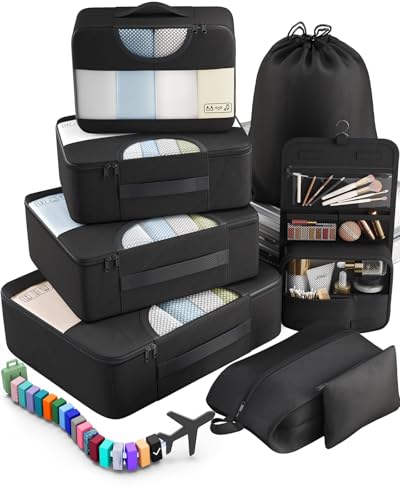In Kiribati, they use Type I power plugs and outlets. The voltage is 240V, and the frequency is 50Hz.
So, you’ll need a travel adapter in Kiribati. Their plugs and outlets are different from the Type A and B ones we use back in the States.
Quick Overview of the Plugs in Kiribati:
- Plug type in Kiribati: I
- Standard voltage: 240V
- Frequency: 50Hz
- Need a travel adapter? Yes, you do need a travel adapter
- Need a voltage converter? Could be necessary for select devices
- Recommended plug adapter: Vintar Universal Travel Adapter Kit
We cross-check our information with official guidelines from local electrical authorities, international IEC standards, and reports from travelers worldwide.
The Only Travel Adapter You’ll Need in Kiribati
Ever landed in a new country, only to realize your charger doesn’t fit? Been there, done that. We don’t sell travel adapters, but we’ve done the research to find the best one for Kiribati—covering voltage, plug types, safety, and price. This one’s a must-have:
Recommended Travel Plug Adapter
by 1,000+ travelers on Amazon
If you’re already abroad and realized you left your adapter at home, don’t stress. You can usually find one at the airport or a local store.
Next time, it’s worth packing one ahead of time—saves time, hassle, and you’ll get one that actually works.
Kiribati is often combined with stops in Fiji, Marshall Islands, or Tuvalu. Make sure your adapter works in each place.
Power Outlets in Kiribati
In Kiribati, they use Type I power plugs and outlets.
Type I

Type I outlets have two flat prongs in a V-shape with a grounding pin and accept both grounded and ungrounded Type I plugs; some ungrounded Type A plugs may fit with an adapter, but grounding will be lost.
Do You Need a Voltage Converter?
A voltage converter is likely needed in Kiribati because your device must match the country’s voltage. The U.S. runs on 120V, but Kiribati uses a different voltage, so a converter is necessary.
Before plugging in your devices abroad, always confirm the power rating on the label. If it lists “100-240V, 50/60 Hz”, your device is designed for worldwide use and won’t require a converter. Many modern gadgets, including laptops, tablets, and cameras, are built this way.

Which Travel Devices May Need a Converter?
Don’t want to guess which converter works? Here are the best-reviewed ones worth checking out.
| Device | Need Converter? | Notes |
|---|---|---|
| Phone | ❌ No (usually) | Most modern phone chargers are dual voltage (100–240V) |
| Laptop | ❌ No (usually) | Check the power brick label for 100–240V |
| Hairdryer | ✅ Yes (often) | High wattage; many models are not dual voltage |
| Electric toothbrush | ⚠️ Check voltage | Some models are 110V only |
| Camera / DSLR | ❌ No (usually) | Most chargers are dual voltage |
| Power bank | ❌ No | Charges via USB, adapter is enough |
| Electric shaver / trimmer | ⚠️ Check voltage | Older or cheaper models may not support 230V |
| Tablet / iPad | ❌ No | All models are dual voltage |
| Portable fan | ✅ Yes (sometimes) | Many models are not compatible with 230V |
| Game console | ⚠️ Check voltage | Newer consoles like PS5 and Xbox are often dual voltage — check to be sure |
| Bluetooth speaker | ❌ No (usually) | Charges via USB |
| E-reader (Kindle, etc.) | ❌ No | USB charging only, no converter needed |
Top Travel Essentials to Pack
With a few key extras, you can avoid a lot of small travel problems. These essentials are smart to bring along.
Digital Luggage Scale
Packing Cubes
Power Bank
More About Kiribati
Kiribati is a remote Pacific nation made up of 33 atolls and one raised coral island, straddling the equator and the 180° meridian, meaning it stretches across multiple hemispheres. The capital area, South Tarawa, is built over several islets connected by causeways and houses roughly half of the country’s 120,000 people. English and Gilbertese are the official languages, and daily life reflects strong traditional culture. It’s a tiny nation by land area—only about 310 square miles—but dispersed over 1.3 million square miles of ocean.
Tourism in Kiribati is small-scale—fewer than 4,000 international visitors arrive per year, generating roughly $5 to $10 million USD. The economy relies mainly on fishing, copra exports, remittances, and aid. There’s minimal infrastructure, but diving and fishing trips around coral atolls like Banaba and Kiritimati offer solitude and largely unexplored reefs. You won’t see luxury hotels—accommodations are basic, family‑run guesthouses or eco‑lodges, making it an off-grid experience for adventurous travelers.
For American travelers, Kiribati feels truly remote—ideal if you’re in search of authentic Pacific island life entirely off the tourist map. Prepare for long flights via Fiji or Hawaii, modest living standards, and few comforts—but rich natural scenery, world-class fishing, and a sense of discovering something rare. It’s not about resorts or beaches—it’s about culture, ocean, sky, and a pace that few places can match.
Kiribati uses the same plugs and outlets as Australia.




